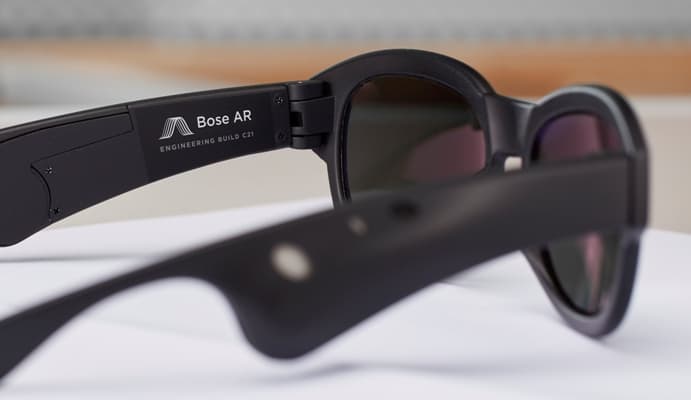Bose’s Radical Take On AR Focuses On Audio
When you hear the term augmented reality (AR) you think of technology that can superimpose digital information over real world visuals. AR has been implemented on smartphone apps and smart glasses to deliver relevant information about the thing you are seeing, but Bose, the leading sound equipment manufacturers think that AR can also deliver audio information as well. At the South by Southwest (SXSW) tech conference Bose has introduced world’s first audio augmented reality platform called Bose AR. As part of this project, Bose has even debut a Bose AR prototype which is a pair of glasses that help you hear. Yes, you read that right, glasses that let you see as well as hear.
Lets us clear the air around Bose AR in simpler terms. In normal AR, digital information in form of visuals is superimposed on real world. In Bose AR instead of visual information, audio information is sent to your ears. The Bose AR is quite different in its implementation as well, at least in its prototype. Its first prototype (Bose AR glasses) that was showcased at SXSW 2018 does not have any cameras. Instead of cameras to capture your location and visuals, Bose uses your smartphone to aggregate GPS information and uses sensors on these glasses to track your head movements and direction in which you are facing. Now this eliminates privacy concerns associated with smart glasses with cameras on them but since GPS information is sometimes sketchy you might end up listening to some completely wrong information.
.jpg)
Keeping on with the Bose AR glasses, they are connected to your smartphone (Android or iOS) with the help of Bluetooth and can be used to make calls and interact with smart assistants like Google Assistant or Siri. Bose AR platform products will deliver audio with the help of ‘wafer-thin minuscule acoustics package. Now we weren’t sure what it meant until we read in the press release that the audio delivered by Bose AR will be completely private. We are making an assumption that Bose AR may be using bone conduction technology to deliver the audio.
.jpg)
Bose claims that Bose AR can be integrated into headphones, eyewear, helmets and more. So how will Bose AR change your life? Bose has detailed the use in its press release. If you are a traveller, Bose AR will deliver sightseeing information. For example if you are looking at a monument like the India Gate, it will tell you about the monument. Even if you are in a closed environment like an airport it shall guide you to your departure gate. The Bose AR glasses can help you translate language like Pixel Buds. You can play and control music with the help of head movements instead of touch gestures.

Bose AR is still in development and final products are far away. Bose has tied up with companies like ASICS Studio, Strava, TripAdvisor, TuneIn and Yelp. It has even collaborated with MIT Media Lab and NYU Future Reality Lap for advanced human interaction related to augmented audio reality. It has dedicated $50 million for start-ups and firms to develop Bose AR experiences. Bose AR SDK will be launched this summer.
Source: #-Link-Snipped-#
Lets us clear the air around Bose AR in simpler terms. In normal AR, digital information in form of visuals is superimposed on real world. In Bose AR instead of visual information, audio information is sent to your ears. The Bose AR is quite different in its implementation as well, at least in its prototype. Its first prototype (Bose AR glasses) that was showcased at SXSW 2018 does not have any cameras. Instead of cameras to capture your location and visuals, Bose uses your smartphone to aggregate GPS information and uses sensors on these glasses to track your head movements and direction in which you are facing. Now this eliminates privacy concerns associated with smart glasses with cameras on them but since GPS information is sometimes sketchy you might end up listening to some completely wrong information.
.jpg)
Keeping on with the Bose AR glasses, they are connected to your smartphone (Android or iOS) with the help of Bluetooth and can be used to make calls and interact with smart assistants like Google Assistant or Siri. Bose AR platform products will deliver audio with the help of ‘wafer-thin minuscule acoustics package. Now we weren’t sure what it meant until we read in the press release that the audio delivered by Bose AR will be completely private. We are making an assumption that Bose AR may be using bone conduction technology to deliver the audio.
.jpg)
Bose claims that Bose AR can be integrated into headphones, eyewear, helmets and more. So how will Bose AR change your life? Bose has detailed the use in its press release. If you are a traveller, Bose AR will deliver sightseeing information. For example if you are looking at a monument like the India Gate, it will tell you about the monument. Even if you are in a closed environment like an airport it shall guide you to your departure gate. The Bose AR glasses can help you translate language like Pixel Buds. You can play and control music with the help of head movements instead of touch gestures.

Bose AR is still in development and final products are far away. Bose has tied up with companies like ASICS Studio, Strava, TripAdvisor, TuneIn and Yelp. It has even collaborated with MIT Media Lab and NYU Future Reality Lap for advanced human interaction related to augmented audio reality. It has dedicated $50 million for start-ups and firms to develop Bose AR experiences. Bose AR SDK will be launched this summer.
Source: #-Link-Snipped-#
0
